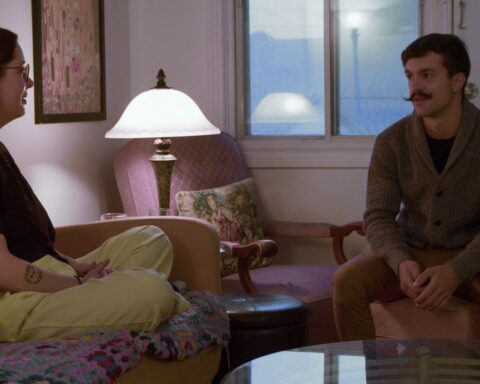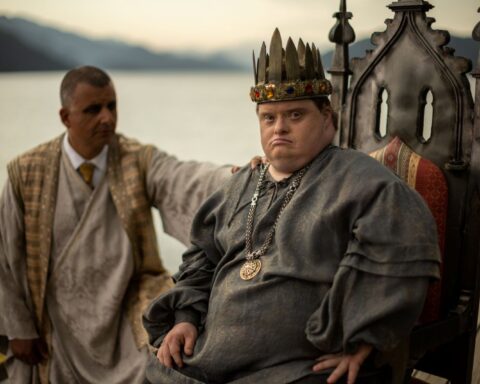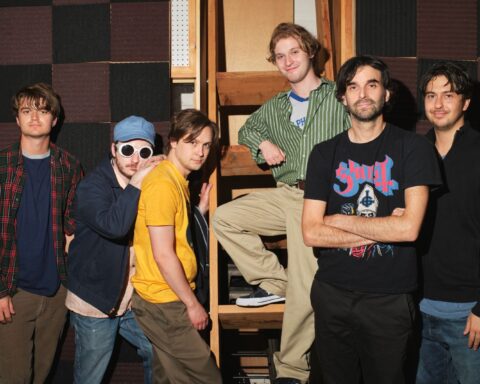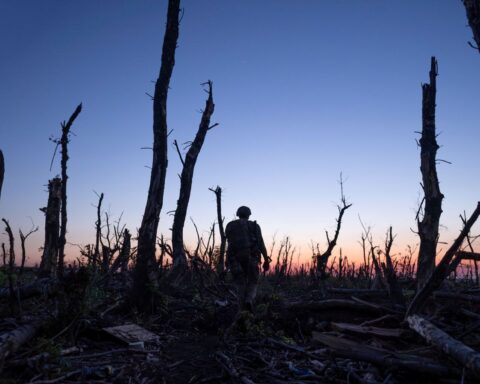Leaving aside the large subset of non-fiction films devoted to celebrity figures of all stripes, documentaries are not star vehicles. This is not to say that there isn’t a star system of sorts in documentary filmmaking. A really well-made and compelling profile documentary can make its subject seem bigger than life, no matter how quotidian his or her existence may actually be; the simple proximity of a movie camera can give even the most self-effacing presences their own powerful gravitational pull.
Some of the most acclaimed American titles at this year’s Hot Docs festival are focused on vividly idiosyncratic protagonists, from Jesse Moss’s controversial yet crowd-pleasing The Overnighters, which depicts a small-town pastor opening his church’s door to transients, to Robert Greene’s Actress, a tricky hybrid work that knowingly exploits the tension between “fake” and “real” to tell the story of a woman trying to restart her career on the stage and screen. But if there’s a through-line between several of this year’s most interesting Canadian selections, it’s that their directors have chosen to eschew an individual focus in favour of an ensemble presentation.
The most extreme example of this tendency is probably Danic Champoux’s Self(less) Portrait, which features several dozen main protagonists—everyday Montrealers corralled by a casting call on the NFB’s Twitter feed and Facebook page. Over the course of the film, these men and women, most of whom seem to be in their 20s, 30s and 40s, relate intimate stories about their lives to an unseen interviewer. The anecdotes cover the entire spectrum of comedy and tragedy, sometimes turning from one to the other and back again, while certain subjects keep turning up within the film’s editing scheme, and others disappear. The effect of this unconventional structure is something akin to a fine collection of short (or even microscopic) stories, each written in its own distinctive vernacular.
“I received 500 applications and accepted 150,” explains Champoux, whose previous Hot Docs entry, 2012’s Mom and Me, used a more stylistically variegated approach to probe the history of the Hell’s Angels. “[I asked] people to write briefly about significant moments in their lives, and then they had to want to come and talk to me. I chose them simply on instinct.” On the evidence of what’s onscreen in Self(less) Portrait, Champoux’s instincts were keen indeed: there are jaw-dropping moments when the interviewees make painful admissions about their romantic and family lives and even confess to fatal transgressions. (One woman’s recollection about being behind the wheel during an accident that killed her partner is truly difficult to watch.) What’s startling is the sense that they’re simply unburdening themselves directly to the lens since the film is edited to efface any sense of directorial prodding. It’s as if the set had simply been dosed with sodium pentothal.
“I think that there are different types of people, each with their own motivations,” says Champoux when quizzed on his subjects’ candor. “I should also point out that the NFB evokes nostalgia, history, and is perceived as a trustworthy, serious institution, which is very reassuring. Some people just wanted to leave their mark. Others wanted to share their experiences in order to help others. And others wanted to show off, but they were eliminated fairly quickly.” Self(less) Portrait is not entirely bereft of attention-getting rhetoric, but while some of the interviews raise the old question of performance in non-fiction filmmaking, Champoux believes that most of what we’re seeing is the real deal. “I believe that many [of the] people were not expecting to unburden themselves as they did and were surprised. Once in front of the camera, knowing that something is expected of you, sometimes you say more than you intend.”
If Self(less) Portrait succeeds as a uniquely cacophonous documentary where no two stories or voices sound alike, Denis Côté’s Joy of Man’s Desiring (Que ta joie demeure) is a harmonious piece of work—even if the harmonics sometimes clank like heavy metal. A clear companion piece to his much-fêted 2012 documentary Bestiaire, Joy of Man’s Desiring swaps out the safari park locale for a factory setting but retains the same head-on aesthetic. The film’s rigidly fixed perspectives capture images of labour and toil in a way that’s at once tactile and abstract, while the sound design stylizes reality in a way that’s reminiscent of Leviathan; in one scene, a package of plastic tape being wound around a trolley’s worth of boxes sounds like a spaceship shifting into warp drive.
“I wanted the film to be hypnotizing,” explains Côté. “You might feel dizzy. It works much better on a big screen at top volume. The sound design and mix are key aspects of the film: exaggerations, layers and layers of effects. I dare you to visit these workplaces. You won’t hear many of the sounds we created in the film. It’s not an observational documentary, and there is a strong desire for fiction.”
That desire has taken Côté’s cinema to many intriguing places over the past decade, but Joy of Man’s Desiring is in some ways a detour because of its group dynamics. In the past, Côté’s doc-fiction hybrids have either been built around a single individual, as in Drifting States (Les états nordiques, 2005) and Carcasses (2009), or else worked around human subjects altogether (Bestiaire’s are all four-legged critters). But the new film does very interesting things with the people onscreen, gradually developing them from figures in a (manufactured) landscape into characters exchanging dialogue back and forth. Hopelessly isolated when glimpsed at their machines, the men and women of Côté’s ensemble are galvanized by their interactions, which play out theatrically, as if in counterpoint to the gruelling monotony of their jobs.
“It’s true that I have a fascination for clashes between observational documentary and stylized fiction, but I’m also afraid of being too austere or too comfortable,” says Côté. “I feel like I’m being too austere if I make a full 70-minute documentary, James Benning-style. And I feel I’m being too comfortable if I just make a narrative film. I think a lot about the audience, so I try to think about humour, and surprises.” He’s succeeded: there are unexpected moments in Joy of Man’s Desiring, especially towards the end, when, in the final confirmation of this hard-shelled movie’s tenderly artistic interior, the workers take in an impromptu musical performance by a young violinist whose presence in the factory is as poetic as it is puzzling. “For me, he represents a counterpoint to all those perfect machines and mechanisms. What I prefer, and what’s beautiful in the end, is the imperfection of Man.”
For more on Côté‘s work, read our 2010 profile.
The boy at the end of Joy of Man’s Desiring is a device of sorts, whereas the adolescent protagonists of Guidelines are definitely flesh-and-blood beings—and all the more fragile for it. Shot in Gaspésie, Que., at a rural high school, Jean-François Caissy’s film is about the transition from innocence to experience, a familiar theme that is given an unusually rigorous workout. Alternating methodically between claustrophobic interrogations between students and school administrators and lyrical outdoor passages where these officially troubled kids seem more or less alright, it’s a structuralist film about structures (academic, social, institutional) and how they variably serve and entrap a younger generation.
“I work mainly by accumulation,” says Caissy. “There are no main characters or preset structures, so the subject gradually dictates the form to me. This approach naturally imposes a certain formal rigour on the shoot and on the editing. I try to create a certain distance between the viewer and the people onscreen. I really like the sense of being both present and a distant observer, hidden behind a movie screen.”
So effectively does Caissy disguise his own presence that some viewers may wonder exactly how he was able to enter into certain situations, especially the ones where his young subjects begin to do very risky things such as clambering heedlessly up the side of a steel bridge, the better to take the plunge into the lake below. “For the exterior scenes, I wanted to show the teens’ situations where they’re in full control of their actions,” he says. “Though they sometimes do some rather dangerous things, I still see these moments of exploration as a way to acquire a kind of maturity. I also wanted to create more lyrical moments that provide space for the comments made in the interviews to resonate.”
Out in the wild, Caissy’s kids seem comfortable in their skins, but in the interview scenes, they’re like tensile bundles of nerves. Guidelines doesn’t focus on any one subject in particular, instead locating repetitions and variations in each student’s respective interactions with their interlocutor. One common denominator is that often the students remain silent for minutes at a time while the adults list off their transgressions, which, while occasionally serious, are more or less commonplace offences. And yet Caissy’s film is not an indictment of its chosen institution. If anything, it evokes the fraught intergenerational politics of the work of Allan King; at times it suggests a cross between Warrendale and Come On Children. “Allan King has made films I really admire,” says Caissy, “and so have Raymond Depardon and Frederick Wiseman. But my main influences come more from the world of fictional films. I’m greatly inspired by directors like Claire Denis, Bela Tarr and Apichatpong [Weerasethakul].”
Thomas Wallner, meanwhile, might cite a slightly older generation of art-house stalwarts. The German-Canadian filmmaker, who copped Hot Docs’ Special Jury Prize in 2011 with the incendiary The Guantanamo Trap (read more about that doc here), once found himself on the other end of the telephone with Alain Resnais (whom he was trying to interview about Night and Fog) and cites Chris Marker as the reason he got into filmmaking in the first place. While not as stylistically radical as Resnais’ non-fiction films (but then, what movies are?), his new feature Before the Last Curtain Falls, which documents the final performance of a Belgian contemporary dance troupe comprised of older homosexual and transsexual performers, is similarly preoccupied with ideas of memory and mortality. Despite its potentially flamboyant subject matter, it’s very much a minor-key work.
“The idea for the film came from Wolfgang Bergmann, the managing director of ARTE in Germany,” says Wallner. “He’s a great admirer of [the choreographer/director] Alain Platel, who created [the show in our film, Gardenia].” A self-taught choreographer who has been compared to the late Pina Bausch, Platel conceived Gardenia as a showcase for older drag performers, with a simple but powerful plot hook: its actors play veteran dancers lamenting the closure of their venerable old cabaret. The art-imitates-life nature of this set-up gets complicated further by Wallner’s film, which introduces a third level of reality: the offstage lives and histories of Gardenia’s stars.
While the sequences documenting the stage show are often lovely and shot in a highly cinematic style that makes no attempt to replicate the perspective of a proscenium, Before the Last Curtain Falls draws most of its power from the everyday material, which is really the main attraction. The differences between an elaborately produced cabaret act and the modest domestic spaces inhabited by its players may seem obvious, but Wallner is more interested in continuity than counterpoint. What’s moving about the film is its insistence that performance is not simply a vocation, but an extension of inner life. “This film has six characters, but it’s really about 12 characters,” he says. “They’ve spent their lives slipping in and out of personas, to the point where they’ve had to redefine themselves in terms of gender. I’ve come to realize that gender is a performance. Not all of the people in my film are transsexual, but some of them are, and it’s as if they’ve made a choice about who they need to be. It’s a compulsion. And then there has to be the crafting of an inner performance.”
Before the Last Curtain Falls addresses this process early on with head-on shots of its subjects methodically dolling themselves up for their farewell performance. It’s a smart tactic, even if the film’s editor, Manfred Becker (who also cut The Guantanamo Trap), was initially opposed to the idea. “I resisted opening with the images of the transitions in front of the mirror, because I thought it was conjuring a stereotype,” he says. “People who were expecting something new would be seeing something associated with homosexual performers. I wanted the transition to be something we saw over the long run. But Thomas insisted on beginning with that joy and fun, and he was right.” Becker was also dubious about the usage of Ravel’s “Boléro” as a through-line on the soundtrack but conceded its effectiveness in the end. “Because it’s been borrowed [in movies] so many times, I just wanted to be sure we gave it a new spin.”
There were no such worries about the deployment of another, more contemporary movie standard: early in Before the Last Curtain Falls, one of the singers does a slow, lilting rendition of “Somewhere Over the Rainbow,” which eloquently crystallizes many of the film’s themes. “If you listen to the lyrics, it’s a song about inclusion, and a place, a paradise, where you can just be who you are. That’s what Oz is. It’s coincidence that the song is a gay anthem. In our film, it’s an anthem for something bigger. We live in a society where if you’re Dorothy, you’re young and beautiful—you’re the It Girl. When you grow wrinkles, nobody wants you, and you’re in this place of longing. That speaks to everyone. It’s where we all end up.”
It’s in that same spirit of inclusivity that Before the Last Curtain Falls maintains a finely balanced focus. Becker’s editing never allows any of the subjects to dominate the proceedings, even if they all have personalities big enough to demand a close-up from Mr. DeMille. Wallner also credits writer Eva Küpper for keeping the movie in that sweet spot between fabulousness and warts-and-all reality. “I think that the two of us, as a man and a woman, were able to approach [the subjects] in an almost familial way,” says Wallner. “It took about a year and a half on and off, spending time with them and shooting. It was [necessary in order] to win [them] over, but I also needed it. The experience of this group, where they come from, their age… It was so very different than where I am in my life.”
Before the Last Curtain Falls, Joy of Man’s Desiring, Self(less) Portrait and Guidelines comprise a telling cross-section of styles and strategies for non-fiction filmmaking, and while each is obviously strong on its own terms, there’s a cumulative satisfaction in stacking them up side by side. It’s a fine ensemble, whose members will all take their bows at Hot Docs—separately, but also together.










